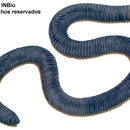Description
(
الإنجليزية
)
المقدمة من AmphibiaWeb articles
Dermophis parviceps is a small slender species of caecilian which grows to 217 mm in length (Savage 2002). It is the most slender caecilian in Costa Rica (Leenders 2001). It can be distinguished by a pink to gray-brown head that contrasts with the purplish slate color of the dorsum (Savage 2002). Ventrally, this caecilian is grayish (Savage 2002). The throat, lower jaw, and the area near the vent are white (Leenders 2001). The eyes are visible through the skin (Savage 2002). A short tentacle is located about halfway between the eye and nostril on each side of its head (Savage 2002; Leenders 2001). The head is elongated (Leenders 2001). This species has both primary and secondary annuli; 85-102 primary annuli and 11-26 secondary annuli may be present, with total numbers of annuli ranging from 97-126 (Savage 2002). The secondary annuli are few in number compared to other sympatric caecilians, and occur at the posterior of the animal near the vent (Leenders 2001). As with all caecilians, there are no external ear openings (Leenders 2001).A Spanish-language species account can be found at the website of Instituto Nacional de Biodiversidad (INBio) (http://darnis.inbio.ac.cr/FMPro?-DB=UBIpub.fp3&-lay=WebAll&-Format=/ubi/detail.html&-Op=bw&id=4325&-Find).
- مؤلف
- Peera Chantasirivisal
Distribution and Habitat
(
الإنجليزية
)
المقدمة من AmphibiaWeb articles
This species occurs in Costa Rica and Panama, from sea level to 1220 m in elevation (Savage, 2002). It inhabits lowland moist and wet forests, premontane moist and wet forests, and premontane rainforest (Savage 2002). It can be found under logs or leaf litter, usually in undisturbed forest (Savage 2002). It may also be found by excavating down to 400-600 mm below the soil surface, in between tree buttresses (Savage 2002).
- مؤلف
- Peera Chantasirivisal
Life History, Abundance, Activity, and Special Behaviors
(
الإنجليزية
)
المقدمة من AmphibiaWeb articles
This is a rare species of caecilian (Savage 2002). These animals are very secretive. They spend most of their time underground or under logs, rocks or leaf litter, seldom venturing into the open (Leenders 2001). Dermophis parviceps is likely to be viviparous, in keeping with the other members of the genus Dermophis. Caecilian larvae from live-bearing species develop within the mother's body, and feed on maternal secretions from the oviduct. Oviductal secretions are stimulated by the larvae's scraping the oviduct wall with specialized fetal teeth. These specialized teeth are replaced after birth with adult teeth, allowing the juveniles and adults to consume a range of invertebrate prey such as worms and insect larvae (Leenders 2001).
- مؤلف
- Peera Chantasirivisal

